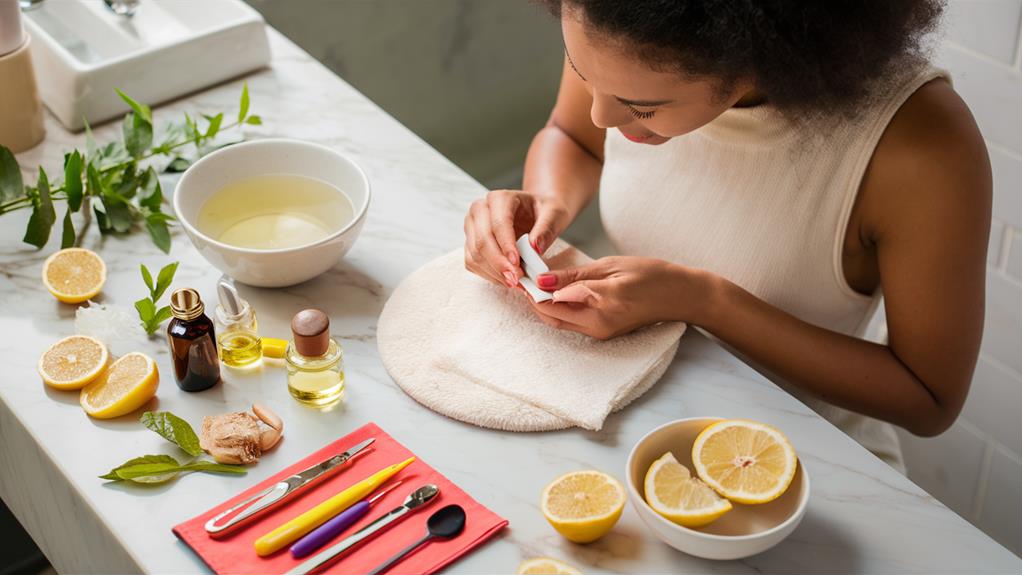To achieve stronger nails, incorporate essential nail care routines into your regimen. Keep your nails hydrated with oils and creams, and regularly moisturize cuticles to protect against infections. Choose the right tools and use gentle filing techniques to avoid splitting. Avoid harsh chemicals by opting for eco-friendly products and wear gloves during cleaning. Maintain a balanced diet rich in biotin and vitamins to support nail health, and limit exposure to water to prevent brittleness. Schedule regular maintenance for professional care and apply strengthening treatments. There's more to explore to enhance your nail care further.
Key Takeaways
- Keep nails hydrated with daily applications of nail oils and hand creams to prevent breakage and enhance appearance.
- Use gentle filing techniques, filing in one direction, to maintain nail integrity and prevent splitting.
- Incorporate nail strengtheners with keratin and calcium to improve nail resilience and overall health.
- Limit exposure to water by wearing gloves during household chores to prevent brittleness and breakage.
- Maintain a balanced diet rich in biotin, vitamin E, and protein to support strong and healthy nails.
Keep Your Nails Hydrated
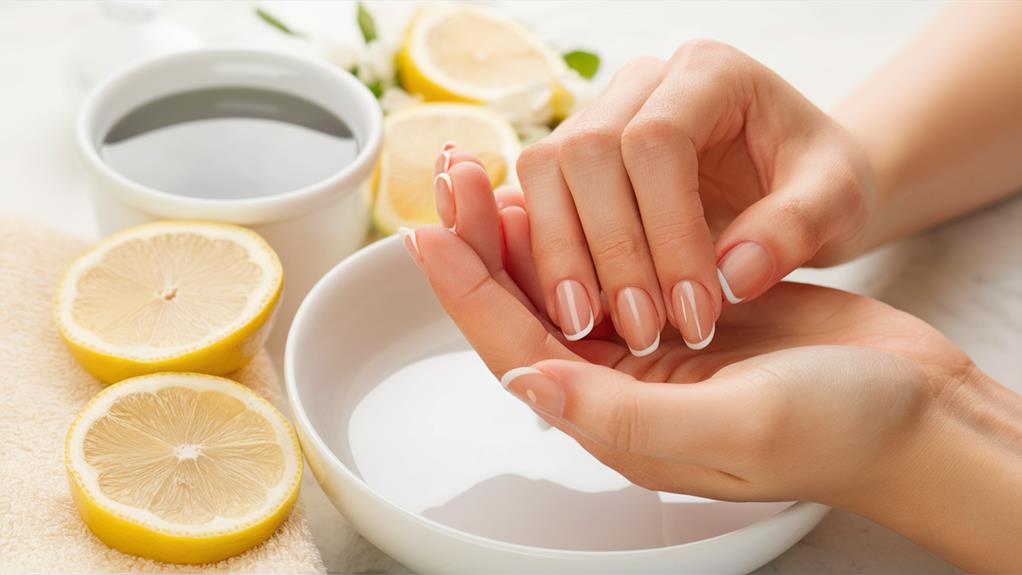
Keeping your nails hydrated is essential for maintaining their strength and preventing breakage. Dry nails are more prone to chipping and splitting, which can lead to discomfort and affect your overall nail appearance. To combat this, incorporating effective hydration techniques into your routine is vital.
Just as Vitamin C serums enhance skin hydration and strength, keeping your nails well-moisturized is key to their resilience.
One of the best ways to keep your nails hydrated is by using nail oil. Nail oils, typically enriched with nourishing ingredients like jojoba or almond oil, penetrate the nail bed and surrounding cuticles, providing essential moisture.
Apply nail oil daily, especially after washing your hands or using hand sanitizers, as these can strip moisture from your nails.
In addition to nail oil, consider integrating a hydrating hand cream into your regimen. Look for creams containing shea butter or glycerin, which are known for their hydrating properties.
Apply the cream not only to your hands but also to your nails and cuticles, ensuring that every part receives adequate moisture.
Furthermore, you can enhance your nail hydration by soaking your fingertips in a mixture of warm water and olive oil for about 10 minutes once a week.
This technique not only hydrates but also promotes blood circulation, benefiting nail health.
Choose the Right Nail Tools
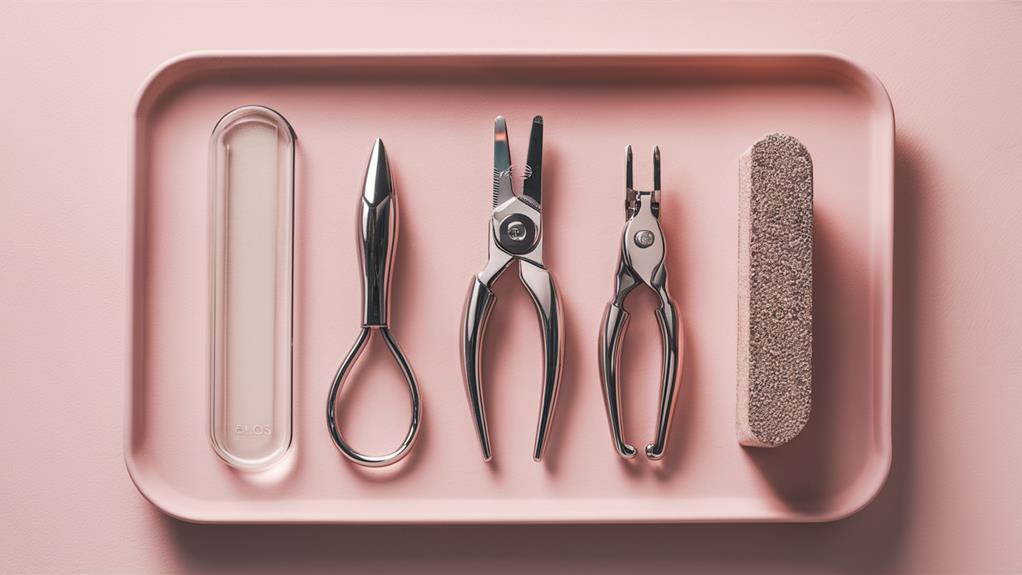
Regularly choosing the right nail tools is essential for maintaining healthy nails and achieving the desired nail shape and finish. Understanding nail tool types is your first step. Invest in essential tools like a high-quality nail clipper, a crystal or glass nail file, cuticle pushers, and nail buffers. Each tool serves a specific purpose: clippers for shortening nails, files for shaping, pushers for managing cuticles, and buffers for giving your nails a glossy finish.
Additionally, just as with cutlery organizers that enhance kitchen efficiency and aesthetics, selecting nail tools that are both functional and visually appealing can elevate your nail care routine. 5 Best Drawer Organizers for effective organization can inspire your nail care setup.
Next, prioritize tool cleaning. Keeping your nail tools clean not only prevents the spread of bacteria but also prolongs the life of your tools. After each use, wipe them down with alcohol or a disinfectant wipe. For more thorough cleaning, soak the tools in a solution of warm water and soap, then rinse and dry them properly. This practice helps maintain hygiene and guarantees that your tools function effectively.
Don't forget to store your tools in a clean, dry place. A dedicated nail care kit can keep everything organized and easily accessible. When you choose the right tools and maintain them properly, you'll notice a significant improvement in your nail care routine.
Practice Gentle Filing Techniques

Gentle filing techniques are essential for preventing nail damage and achieving a smooth finish. When you file your nails, you want to guarantee that you're enhancing your fingernail shape without compromising their integrity. The right filing direction can make all the difference in maintaining their strength.
When filing, always move in one direction rather than back and forth. This reduces the risk of splitting or tearing your nails. Start from the outer edge of your nail and file towards the center. Depending on your desired fingernail shape—whether it's square, oval, or almond—adjust your technique accordingly.
Here's a quick reference table to help you understand the best practices for gentle filing:
| Fingernail Shape | Filing Direction |
|---|---|
| Square | File straight across |
| Oval | File from the sides inward |
| Almond | File sides with a slight curve |
| Coffin | File edges straight, taper inward |
| Stiletto | File edges to a pointed tip |
Using a fine-grit file can also minimize damage, as it provides a smoother finish. Remember to keep your nails dry before filing, as damp nails are more susceptible to bending and breaking. By practicing these gentle filing techniques, you'll not only achieve a polished look but also guarantee your nails remain strong and healthy. So, take your time and enjoy the process—your nails will thank you!
Avoid Harsh Chemicals
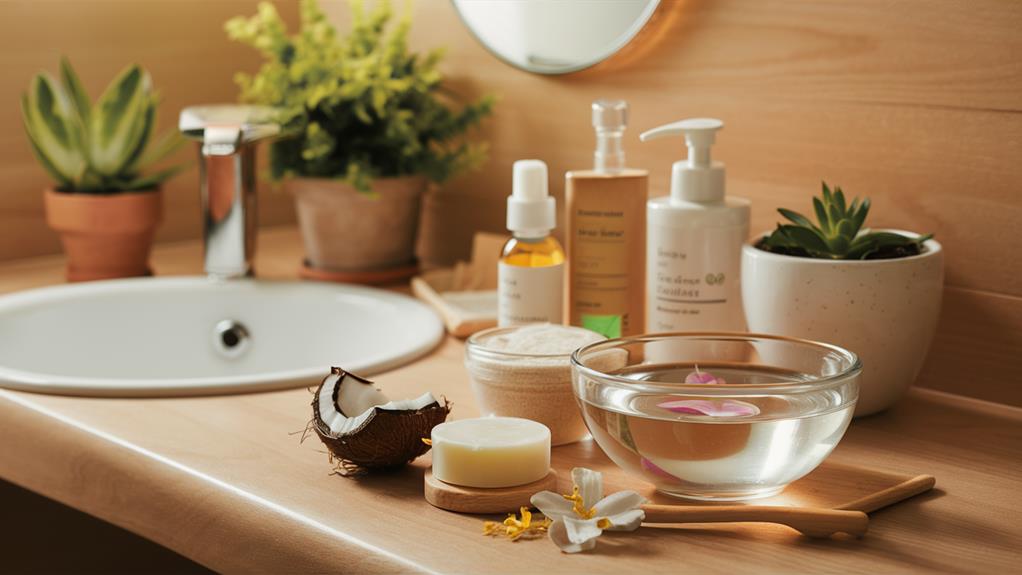
While maintaining your nails through proper filing techniques is important, it's equally essential to protect them from harsh chemicals. Many conventional nail care products contain aggressive ingredients that can weaken your nails over time. These chemicals can lead to brittleness, peeling, and even infections.
To avoid this, consider switching to chemical-free products that prioritize your nail health. Additionally, using products like eco-friendly detergents can further reduce your exposure to harmful substances in your daily routine.
When shopping for nail care items, look for brands that emphasize natural alternatives. These products often use plant-based ingredients that nourish your nails without the damaging effects of synthetic chemicals.
For example, instead of traditional nail polish removers laden with acetone, try using non-acetone removers or those made from natural oils. These alternatives not only remove polish effectively but also condition your nails.
Additionally, explore chemical-free nail polishes that utilize natural pigments and non-toxic formulas. These polishes tend to be less harmful and are available in a wide range of colors, allowing you to express your style without compromising your nail health.
It's also wise to be mindful of everyday items that may contain harsh chemicals, such as cleaning supplies. Opt for eco-friendly cleaners or create your own using simple ingredients like vinegar and baking soda.
By making these conscious choices, you not only protect your nails but also contribute to a healthier environment.
Your nails deserve the best care possible, and avoiding harsh chemicals is a significant step toward achieving strong, beautiful nails. Embrace natural alternatives, and watch your nails thrive.
Maintain a Balanced Diet

A balanced diet is essential for maintaining strong and healthy nails. The health of your nails often reflects what you consume, so paying attention to your diet can have significant impacts. Make sure you're incorporating a variety of nutrients, particularly vitamins and proteins, to support nail strength.
Vitamin benefits are important; for instance, biotin (a B vitamin) is known to improve nail thickness and reduce brittleness. Foods rich in biotin include eggs, nuts, and whole grains.
Similarly, vitamin E helps in maintaining nail moisture, which is essential for preventing breakage. You can find vitamin E in leafy greens, avocados, and seeds.
Moreover, proteins are the building blocks of your nails, so incorporating quality protein sources into your meals is key. Lean meats, fish, eggs, legumes, and dairy products not only bolster your overall health but also provide your nails with the necessary structure.
Don't overlook the importance of hydration; drinking plenty of water facilitates nutrient absorption and contributes to overall nail health.
Incorporate Nail Strengtheners

To enhance your nail strength further, incorporating nail strengtheners into your routine can make a noticeable difference. Nail strengtheners often contain specific ingredients that promote resilience and fortitude in your nails.
Look for formulations featuring keratin, a protein that's essential for nail structure, and calcium, which helps to strengthen and harden your nails. Other beneficial nail strengthener ingredients include vitamins A, C, and E, which support overall nail health and hydration.
When using nail strengtheners, ideal application techniques are vital for achieving the best results. Start with clean, dry nails to guarantee the strengthener adheres properly.
Apply a thin layer of the strengthener to your nails, avoiding the cuticle area to prevent irritation. Allow the product to dry completely before applying additional layers or nail polish. For maximum effectiveness, consider using the strengthener every few days, allowing your nails to absorb the beneficial ingredients.
It's also wise to choose a strengthener that fits your specific needs. If you have weak, brittle nails, opt for a product designed to restore strength and flexibility.
Conversely, if your nails are prone to splitting, look for one that emphasizes protection. By integrating nail strengtheners into your nail care regimen, you'll foster a supportive environment for growth and resilience, making your nails not only look good but also feel strong and healthy.
Limit Exposure to Water
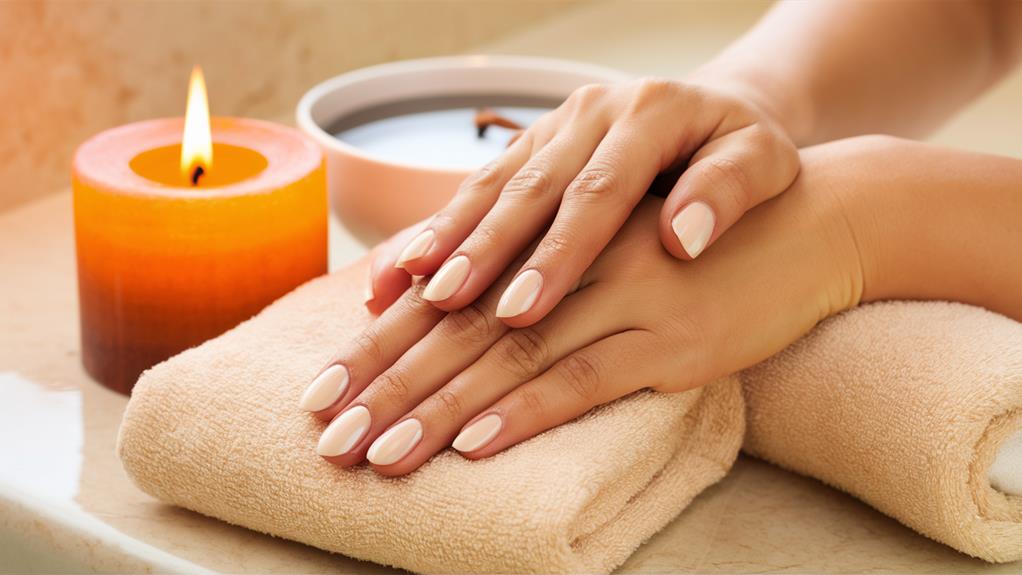
Excessive exposure to water can undermine your nail health, leading to weakening and increased susceptibility to breakage.
When your nails absorb too much water, it can cause nail brittleness, making them prone to chipping and splitting. To maintain strong nails, it's crucial to limit your nails' exposure to water.
Here are three practical steps you can take:
- Wear Gloves: Whenever you're doing dishes, cleaning, or engaging in any activity that involves prolonged water exposure, put on a pair of gloves. This simple barrier protects your nails from excessive water absorption.
- Limit Soaking: Try to cut down on lengthy baths or hot tubs. While soaking can be relaxing, it can also lead to excessive moisture, weakening your nails over time. Opt for shorter showers instead.
- Dry Thoroughly: After washing your hands or swimming, make sure you dry your nails completely. Moisture trapped under your nails can contribute to brittleness and breakage, so take the extra moment to pat them dry.
Regularly Moisturize Cuticles
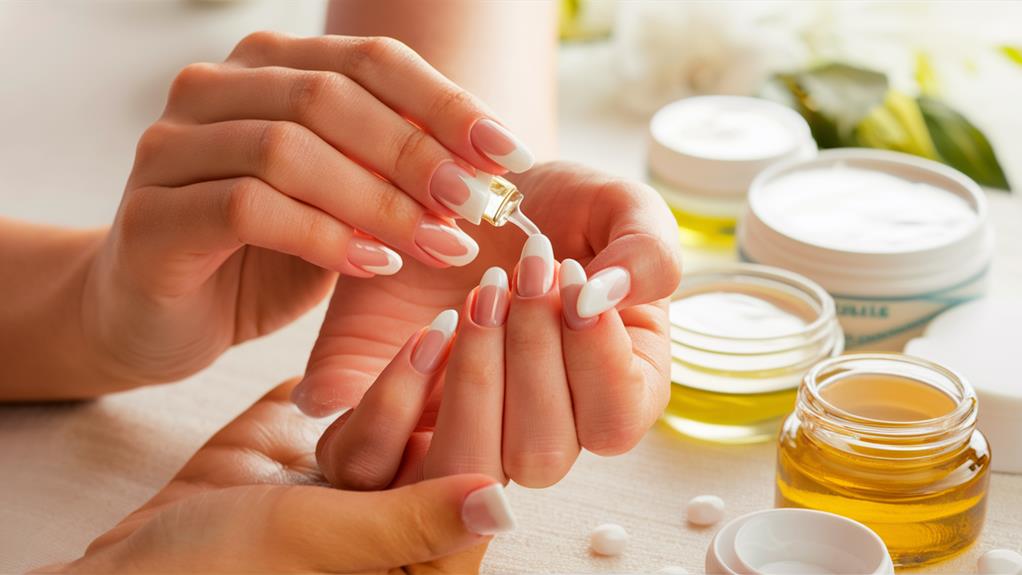
Maintaining nail health goes beyond just protecting them from water; caring for your cuticles is equally important. Your cuticles serve as a protective barrier, preventing bacteria and infections from entering the nail bed. Regularly moisturizing them not only keeps them healthy but also enhances the overall appearance of your nails.
To effectively moisturize your cuticles, you should incorporate cuticle oils into your routine. These oils, often enriched with vitamins and essential nutrients, penetrate deeply to nourish and hydrate the skin surrounding your nails. Applying cuticle oil daily, especially after washing your hands or using hand sanitizer, can greatly improve the condition of your cuticles.
When applying cuticle oil, use gentle massage techniques. Start by placing a drop of the oil on each cuticle, then use your fingertip to massage it in a circular motion. This not only distributes the oil evenly but also stimulates blood circulation, promoting healthier nail growth.
You can also push back the cuticles gently with a wooden stick or your fingers after the oil has soaked in, which helps maintain a neat appearance.
Make it a habit to include cuticle care in your nail care routine. A few minutes each day can lead to stronger, healthier nails and beautifully manicured hands. By prioritizing the health of your cuticles, you create a foundation for vibrant nails and a sense of belonging in the community of nail care enthusiasts.
Protect Nails With Gloves
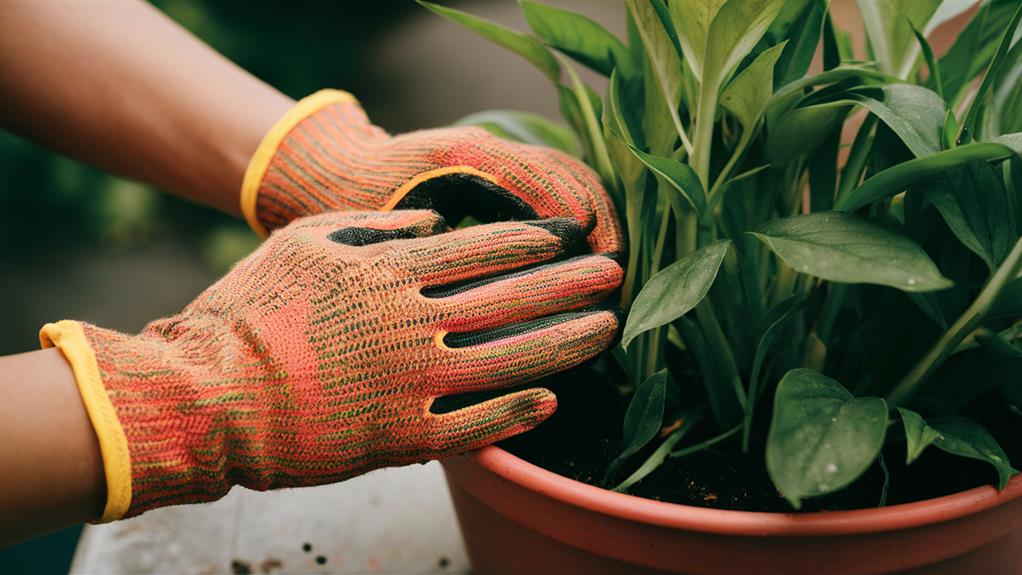
Wearing gloves is essential for protecting your nails from damage caused by harsh chemicals, excessive moisture, and physical trauma. By using gloves, you create a protective barrier that helps maintain the integrity of your nails and surrounding skin.
Here are some key nail glove benefits:
- Chemical Protection: Household cleaners, detergents, and other chemicals can weaken your nails and lead to peeling or breakage. Gloves shield your nails from these damaging substances.
- Moisture Control: Excessive moisture can cause nails to become soft and prone to breakage. Wearing gloves while washing dishes or cleaning prevents overexposure to water, keeping your nails strong and resilient.
- Physical Defense: Your nails are vulnerable to physical damage during everyday tasks. Gloves act as a protective barrier against accidental bumps, cuts, or scrapes that could lead to nail injury.
Incorporating gloves into your daily routine isn't just about aesthetics; it's a proactive step toward healthier nails.
Whether you're gardening, cleaning, or doing any task that puts your hands at risk, remember that a simple pair of gloves can make all the difference.
By prioritizing nail protection, you're investing in your overall nail health, which fosters a sense of belonging within your community of nail care enthusiasts.
Take this step today, and watch your nails thrive!
Schedule Regular Nail Maintenance
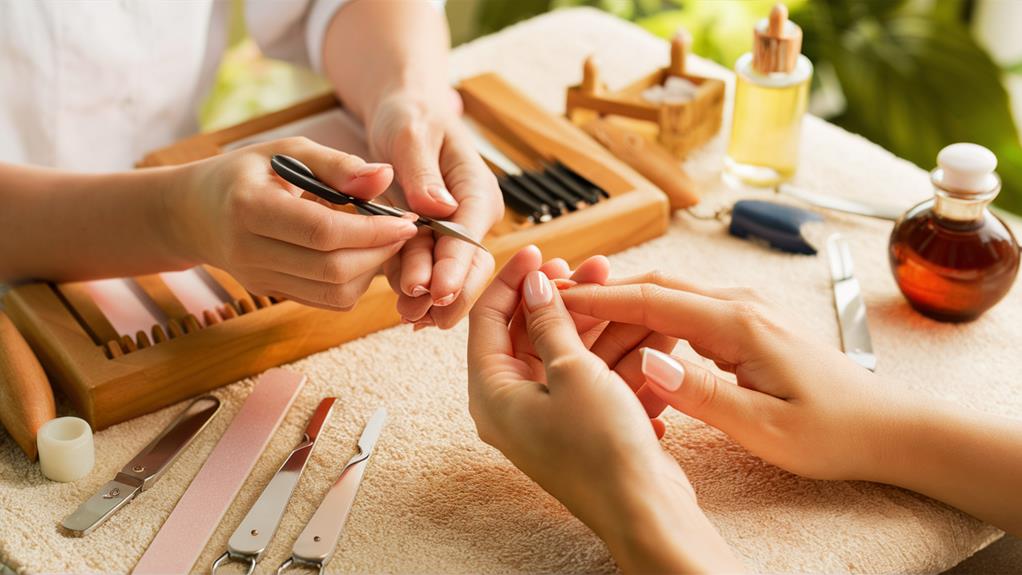
Scheduling regular nail maintenance is crucial for keeping your nails in ideal condition. Establishing a routine not only enhances the appearance of your nails but also promotes their overall health. Aim for monthly nail salon visits, where trained professionals can assess your nail health, trim cuticles, and provide vital treatments tailored to your needs.
During these visits, you can explore various nail art techniques that add flair to your look while maintaining your nails' integrity. For instance, gel manicures can offer a long-lasting finish without compromising nail strength. Opt for services that prioritize nail health, such as non-toxic polishes and treatments designed to strengthen nails.
In between salon visits, maintain your routine at home. Regularly moisturize your cuticles and nails with nourishing oils or creams to keep them hydrated and prevent brittleness. You might also consider weekly upkeep, like filing and shaping your nails, which can help prevent snags and breaks.
Don't forget about the importance of proper nail tools. Invest in high-quality nail clippers, files, and buffers to guarantee you're maintaining your nails effectively.
Frequently Asked Questions
How Often Should I Trim My Nails?
You should trim your nails every 1 to 2 weeks, depending on nail trimming frequency and individual nail growth factors.
Factors like genetics, diet, and overall health can influence how quickly your nails grow. Regular trimming helps prevent breakage and maintains a neat appearance.
If you notice your nails growing faster, adjust your schedule accordingly. Keeping an eye on your nails will guarantee they stay healthy and strong.
Can I Use Regular Lotion on My Nails?
Yes, you can use regular lotion on your nails, but it's best to choose one that's rich in moisturizing ingredients.
Lotion benefits include nail hydration, which helps prevent brittleness and splitting. Look for lotions containing shea butter, glycerin, or oils to enhance moisture retention.
Applying lotion regularly can improve your nails' overall appearance and health, making them less prone to damage. Just make sure to massage it into both your nails and cuticles for best results.
What Are the Signs of Unhealthy Nails?
Did you know that nearly 20% of people experience nail issues at some point in their lives?
Unhealthy nails often show signs like discoloration, which can be caused by infections or underlying health conditions.
You might also notice nail brittleness, which can be remedied by incorporating biotin into your diet or using moisturizing treatments.
Keeping an eye on these signs helps you maintain not just nail health but overall well-being too.
Is It Okay to Apply Nail Polish Daily?
Applying nail polish daily can offer aesthetic benefits, but it also comes with risks. Frequent application may lead to weakened nails, peeling, or discoloration due to the chemicals in some polishes.
To maintain nail health, consider giving your nails a break periodically. Use a base coat to minimize damage, and opt for breathable formulas.
Balancing the appeal of nail polish with the potential risks guarantees your nails stay strong and beautiful over time.
How Do I Choose a Nail Salon?
When choosing a nail salon, it's essential to prioritize nail salon hygiene and the qualifications of the nail technicians.
Look for salons that maintain cleanliness, use sterilized tools, and follow health regulations.
Check reviews and ask about the technicians' certifications and experience.
A reputable salon guarantees your safety while providing quality service, making you feel valued and comforted during your visit.
Conclusion
Incorporating these ten essential nail care routines into your lifestyle can lead to stronger, healthier nails. Just like a knight wouldn't venture into battle without their armor, you shouldn't neglect your nail care. By keeping your nails hydrated, choosing the right tools, and avoiding harsh chemicals, you'll create a solid foundation for nail strength. Remember, consistency is key—so commit to these routines, and soon you'll notice the difference in your nail health.

